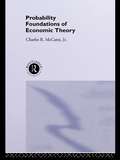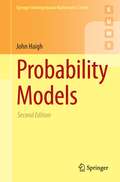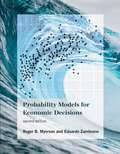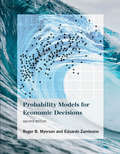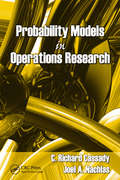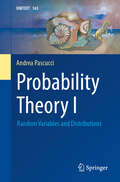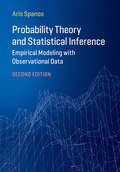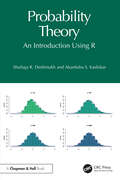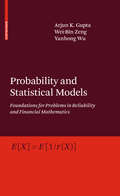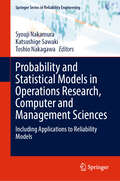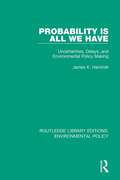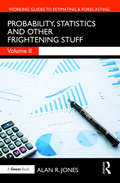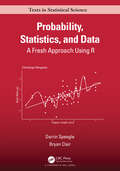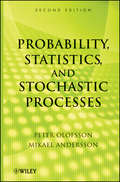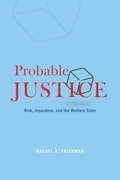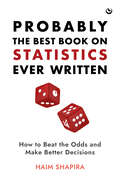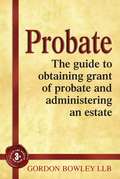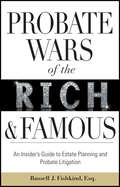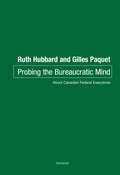- Table View
- List View
Probability Foundations of Economic Theory
by Charles McCannFirst published in 1994. Routledge is an imprint of Taylor & Francis, an informa company.
Probability Models
by John HaighThe purpose of this book is to provide a sound introduction to the study of real-world phenomena that possess random variation. It describes how to set up and analyse models of real-life phenomena that involve elements of chance. Motivation comes from everyday experiences of probability, such as that of a dice or cards, the idea of fairness in games of chance, and the random ways in which, say, birthdays are shared or particular events arise. Applications include branching processes, random walks, Markov chains, queues, renewal theory, and Brownian motion. This popular second edition textbook contains many worked examples and several chapters have been updated and expanded. Some mathematical knowledge is assumed. The reader should have the ability to work with unions, intersections and complements of sets; a good facility with calculus, including integration, sequences and series; and appreciation of the logical development of an argument. Probability Models is designed to aid students studying probability as part of an undergraduate course on mathematics or mathematics and statistics.
Probability Models for Economic Decisions (The MIT Press)
by Roger B. Myerson Eduardo ZambranoAn introduction to the use of probability models for analyzing risk and economic decisions, using spreadsheets to represent and simulate uncertainty.This textbook offers an introduction to the use of probability models for analyzing risks and economic decisions. It takes a learn-by-doing approach, teaching the student to use spreadsheets to represent and simulate uncertainty and to analyze the effect of such uncertainty on an economic decision. Students in applied business and economics can more easily grasp difficult analytical methods with Excel spreadsheets. The book covers the basic ideas of probability, how to simulate random variables, and how to compute conditional probabilities via Monte Carlo simulation. The first four chapters use a large collection of probability distributions to simulate a range of problems involving worker efficiency, market entry, oil exploration, repeated investment, and subjective belief elicitation. The book then covers correlation and multivariate normal random variables; conditional expectation; optimization of decision variables, with discussions of the strategic value of information, decision trees, game theory, and adverse selection; risk sharing and finance; dynamic models of growth; dynamic models of arrivals; and model risk. New material in this second edition includes two new chapters on additional dynamic models and model risk; new sections in every chapter; many new end-of-chapter exercises; and coverage of such topics as simulation model workflow, models of probabilistic electoral forecasting, and real options. The book comes equipped with Simtools, an open-source, free software used througout the book, which allows students to conduct Monte Carlo simulations seamlessly in Excel.
Probability Models for Economic Decisions, second edition (The\mit Press Ser.)
by Roger B. Myerson Eduardo ZambranoAn introduction to the use of probability models for analyzing risk and economic decisions, using spreadsheets to represent and simulate uncertainty.This textbook offers an introduction to the use of probability models for analyzing risks and economic decisions. It takes a learn-by-doing approach, teaching the student to use spreadsheets to represent and simulate uncertainty and to analyze the effect of such uncertainty on an economic decision. Students in applied business and economics can more easily grasp difficult analytical methods with Excel spreadsheets. The book covers the basic ideas of probability, how to simulate random variables, and how to compute conditional probabilities via Monte Carlo simulation. The first four chapters use a large collection of probability distributions to simulate a range of problems involving worker efficiency, market entry, oil exploration, repeated investment, and subjective belief elicitation. The book then covers correlation and multivariate normal random variables; conditional expectation; optimization of decision variables, with discussions of the strategic value of information, decision trees, game theory, and adverse selection; risk sharing and finance; dynamic models of growth; dynamic models of arrivals; and model risk. New material in this second edition includes two new chapters on additional dynamic models and model risk; new sections in every chapter; many new end-of-chapter exercises; and coverage of such topics as simulation model workflow, models of probabilistic electoral forecasting, and real options. The book comes equipped with Simtools, an open-source, free software used througout the book, which allows students to conduct Monte Carlo simulations seamlessly in Excel.
Probability Models in Operations Research (Operations Research Series)
by Joel A. Nachlas C. Richard CassadyIndustrial engineering has expanded from its origins in manufacturing to transportation, health care, logistics, services, and more. A common denominator among all these industries, and one of the biggest challenges facing decision-makers, is the unpredictability of systems. Probability Models in Operations Research provides a comprehensive
Probability Models in Reliability Analysis (University Texts in the Mathematical Sciences)
by S. P. Mukherjee Asok K. NandaThis book delves into the fundamental theoretical aspects of reliability analysis, focusing on various probabilistic models. These models are essential for representing random variations in underlying variables such as time-to-failure, the number of failures between consecutive repairs and similar metrics. The calculation, estimation and prediction of reliability all hinge on using appropriate probability models. The book introduces various models beneficial for researchers in the field of reliability. It also provides a comprehensive overview of the available models, highlighting their distinctive features and practical applications in a narrative format. The content of the book is designed to appeal to a broad readership. Students and researchers in the field of reliability analysis will find a comprehensive yet easily understandable summary of models applicable to their data sets of interest. It should be noted, however, As stated clearly in the preface, this book does not illustrate applications of the models discussed in terms of real-life data.
Probability Theory I: Random Variables and Distributions (UNITEXT #165)
by Andrea PascucciThis book provides a concise yet rigorous introduction to probability theory. Among the possible approaches to the subject, the most modern approach based on measure theory has been chosen: although it requires a higher degree of mathematical abstraction and sophistication, it is essential to provide the foundations for the study of more advanced topics such as stochastic processes, stochastic differential calculus and statistical inference. The text originated from the teaching experience in probability and applied mathematics courses within the mathematics degree program at the University of Bologna; it is suitable for second- or third-year students in mathematics, physics, or other natural sciences, assuming multidimensional differential and integral calculus as a prerequisite. The four chapters cover the following topics: measures and probability spaces; random variables; sequences of random variables and limit theorems; and expectation and conditional distribution. The text includes a collection of solved exercises.
Probability Theory and Statistical Inference: Empirical Modeling with Observational Data
by Aris SpanosDoubt over the trustworthiness of published empirical results is not unwarranted and is often a result of statistical mis-specification: invalid probabilistic assumptions imposed on data. Now in its second edition, this bestselling textbook offers a comprehensive course in empirical research methods, teaching the probabilistic and statistical foundations that enable the specification and validation of statistical models, providing the basis for an informed implementation of statistical procedure to secure the trustworthiness of evidence. Each chapter has been thoroughly updated, accounting for developments in the field and the author's own research. The comprehensive scope of the textbook has been expanded by the addition of a new chapter on the Linear Regression and related statistical models. This new edition is now more accessible to students of disciplines beyond economics and includes more pedagogical features, with an increased number of examples as well as review questions and exercises at the end of each chapter.
Probability Theory: An Introduction Using R
by Shailaja R. Deshmukh Akanksha S. KashikarThis book introduces Probability Theory with R software and explains abstract concepts in a simple and easy-to-understand way by combining theory and computation. It discusses conceptual and computational examples in detail, to provide a thorough understanding of basic techniques and develop an enjoyable read for students seeking suitable material for self-study. It illustrates fundamental concepts including fields, sigma-fields, random variables and their expectations, various modes of convergence of a sequence of random variables, laws of large numbers and the central limit theorem. Computational exercises based on R software are included in each Chapter Includes a brief introduction to the basic functions of R software for beginners in R and serves as a ready reference Includes Numerical computations, simulation studies, and visualizations using R software as easy tools to explain abstract concepts Provides multiple-choice questions for practice Incorporates self-explanatory R codes in every chapter This textbook is for advanced students, professionals, and academic researchers of Statistics, Biostatistics, Economics and Mathematics.
Probability and Statistical Models
by Arjun K. Gupta Yanhong Wu Wei-Bin ZengWith an emphasis on models and techniques, this textbook introduces many of the fundamental concepts of stochastic modeling that are now a vital component of almost every scientific investigation. In particular, emphasis is placed on laying the foundation for solving problems in reliability, insurance, finance, and credit risk. The material has been carefully selected to cover the basic concepts and techniques on each topic, making this an ideal introductory gateway to more advanced learning. With exercises and solutions to selected problems accompanying each chapter, this textbook is for a wide audience including advanced undergraduate and beginning-level graduate students, researchers, and practitioners in mathematics, statistics, engineering, and economics.
Probability and Statistical Models in Operations Research, Computer and Management Sciences: Including Applications to Reliability Models (Springer Series in Reliability Engineering)
by Toshio Nakagawa Syouji Nakamura Katsushige SawakiThis book explores the convergence of stochastic modeling, reliability tools, and the quest for solutions in an era of globalized challenges. The tools have become only more important in the unforeseen emergencies such as the COVID-19 pandemic and the conflict in Ukraine. This comprehensive book is an invaluable resource for graduate students seeking practical knowledge on probability and statistics in real-world applications. The book is divided into four parts: reliability, computer science, management science, and operations research. Each part includes surveys, recent results, and tools used. Moreover, it offers an essential reference point for researchers, engineers, and managers operating in laboratories, industries, businesses, and government agencies. Through the exchange of academic achievements, ideas, and discussions, this book serves as a catalyst for progress and innovation.
Probability and Statistics for Data Science: Math + R + Data (Chapman & Hall/CRC Data Science Series)
by Norman MatloffProbability and Statistics for Data Science: Math + R + Data covers "math stat"—distributions, expected value, estimation etc.—but takes the phrase "Data Science" in the title quite seriously: <P><P> * Real datasets are used extensively. * All data analysis is supported by R coding. * Includes many Data Science applications, such as PCA, mixture distributions, random graph models, Hidden Markov models, linear and logistic regression, and neural networks. * Leads the student to think critically about the "how" and "why" of statistics, and to "see the big picture." * Not "theorem/proof"-oriented, but concepts and models are stated in a mathematically precise manner. <P><P> Prerequisites are calculus, some matrix algebra, and some experience in programming. <P><P> Norman Matloff is a professor of computer science at the University of California, Davis, and was formerly a statistics professor there. He is on the editorial boards of the Journal of Statistical Software and The R Journal. His book Statistical Regression and Classification: From Linear Models to Machine Learning was the recipient of the Ziegel Award for the best book reviewed in Technometrics in 2017. He is a recipient of his university's Distinguished Teaching Award.
Probability and Statistics for Finance
by Frank J. Fabozzi Rachev Svetlozar T. Markus Hoechstoetter Focardi Sergio M.A comprehensive look at how probability and statistics is applied to the investment process Finance has become increasingly more quantitative, drawing on techniques in probability and statistics that many finance practitioners have not had exposure to before. In order to keep up, you need a firm understanding of this discipline. Probability and Statistics for Finance addresses this issue by showing you how to apply quantitative methods to portfolios, and in all matter of your practices, in a clear, concise manner. Informative and accessible, this guide starts off with the basics and builds to an intermediate level of mastery. * Outlines an array of topics in probability and statistics and how to apply them in the world of finance * Includes detailed discussions of descriptive statistics, basic probability theory, inductive statistics, and multivariate analysis * Offers real-world illustrations of the issues addressed throughout the text The authors cover a wide range of topics in this book, which can be used by all finance professionals as well as students aspiring to enter the field of finance.
Probability for Finance
by Tomasz Zastawniak Ekkehard Kopp Jan MalczakStudents and instructors alike will benefit from this rigorous, unfussy text, which keeps a clear focus on the basic probabilistic concepts required for an understanding of financial market models, including independence and conditioning. Assuming only some calculus and linear algebra, the text develops key results of measure and integration, which are applied to probability spaces and random variables, culminating in central limit theory. Consequently it provides essential prerequisites to graduate-level study of modern finance and, more generally, to the study of stochastic processes. Results are proved carefully and the key concepts are motivated by concrete examples drawn from financial market models. Students can test their understanding through the large number of exercises and worked examples that are integral to the text.
Probability in Economics (Routledge Frontiers of Political Economy #5)
by Omar Hamouda Robin RowleyNotions of probability and uncertainty have been increasingly prominant in modern economics. This book considers the philosophical and practical difficulties inherent in integrating these concepts into realistic economic situations. It outlines and evaluates the major developments, indicating where further work is needed. This book addresses: * probability, utility and rationality within current economic thought and practice * concepts of ignorance and indeterminancy * experimental economics * econometrics, with particular reference inference and estimation.
Probability is All We Have: Uncertainties, Delays, and Environmental Policy Making (Routledge Library Editions: Environmental Policy #10)
by James K. HammittFirst published in 1990. In this study, the author suggests ways that policy-makers can think about environmental policy choice that responds to the importance of uncertainty and delay. Hammitt describes several tools for environmental policy analysis and illustrates their application to important policy issues. In the first part of the book, dealing with stratospheric-ozone depletion, the author describes techniques for accommodating outcome uncertainties. The second part of the study considers the health risks associated with pesticide residues on food. The final section addresses the issue of potential global climate change, and describes how the tools explored can be applied to this new challenge. This book should be of greatest interest to academic, government, and industry analysts and others concerned with improving methods for environmental-policy making.
Probability, Statistics and Other Frightening Stuff (Working Guides to Estimating & Forecasting #2)
by Alan R. JonesProbability, Statistics and Other Frightening Stuff (Volume II of the Working Guides to Estimating & Forecasting series) considers many of the commonly used Descriptive Statistics in the world of estimating and forecasting. It considers values that are representative of the ‘middle ground’ (Measures of Central Tendency), and the degree of data scatter (Measures of Dispersion and Shape) around the ‘middle ground’ values. A number of Probability Distributions and where they might be used are discussed, along with some fascinating and useful ‘rules of thumb’ or short-cut properties that estimators and forecasters can exploit in plying their trade. With the help of a ‘Correlation Chicken’, the concept of partial correlation is explained, including how the estimator or forecaster can exploit this in reflecting varying levels of independence and imperfect dependence between an output or predicted value (such as cost) and an input or predictor variable such as size. Under the guise of ‘Tails of the unexpected’ the book concludes with two chapters devoted to Hypothesis Testing (or knowing when to accept or reject the validity of an assumed estimating relationship), and a number of statistically-based tests to help the estimator to decide whether to include or exclude a data point as an ‘outlier’, one that appears not to be representative of that which the estimator is tasked to produce. This is a valuable resource for estimators, engineers, accountants, project risk specialists as well as students of cost engineering.
Probability, Statistics, and Data: A Fresh Approach Using R (Chapman & Hall/CRC Texts in Statistical Science)
by Darrin Speegle Bryan ClairThis book is a fresh approach to a calculus based, first course in probability and statistics, using R throughout to give a central role to data and simulation. The book introduces probability with Monte Carlo simulation as an essential tool. Simulation makes challenging probability questions quickly accessible and easily understandable. Mathematical approaches are included, using calculus when appropriate, but are always connected to experimental computations. Using R and simulation gives a nuanced understanding of statistical inference. The impact of departure from assumptions in statistical tests is emphasized, quantified using simulations, and demonstrated with real data. The book compares parametric and non-parametric methods through simulation, allowing for a thorough investigation of testing error and power. The text builds R skills from the outset, allowing modern methods of resampling and cross validation to be introduced along with traditional statistical techniques. Fifty-two data sets are included in the complementary R package fosdata. Most of these data sets are from recently published papers, so that you are working with current, real data, which is often large and messy. Two central chapters use powerful tidyverse tools (dplyr, ggplot2, tidyr, stringr) to wrangle data and produce meaningful visualizations. Preliminary versions of the book have been used for five semesters at Saint Louis University, and the majority of the more than 400 exercises have been classroom tested.
Probability, Statistics, and Stochastic Processes
by Peter Olofsson Mikael AnderssonPraise for the First Edition ". . . an excellent textbook . . . well organized and neatly written. " --Mathematical Reviews ". . . amazingly interesting . . . " --Technometrics Thoroughly updated to showcase the interrelationships between probability, statistics, and stochastic processes, Probability, Statistics, and Stochastic Processes, Second Edition prepares readers to collect, analyze, and characterize data in their chosen fields. Beginning with three chapters that develop probability theory and introduce the axioms of probability, random variables, and joint distributions, the book goes on to present limit theorems and simulation. The authors combine a rigorous, calculus-based development of theory with an intuitive approach that appeals to readers' sense of reason and logic. Including more than 400 examples that help illustrate concepts and theory, the Second Edition features new material on statistical inference and a wealth of newly added topics, including: Consistency of point estimators Large sample theory Bootstrap simulation Multiple hypothesis testing Fisher's exact test and Kolmogorov-Smirnov test Martingales, renewal processes, and Brownian motion One-way analysis of variance and the general linear model Extensively class-tested to ensure an accessible presentation, Probability, Statistics, and Stochastic Processes, Second Edition is an excellent book for courses on probability and statistics at the upper-undergraduate level. The book is also an ideal resource for scientists and engineers in the fields of statistics, mathematics, industrial management, and engineering.
Probable Justice: Risk, Insurance, and the Welfare State
by Rachel Z. FriedmanDecades into its existence as a foundational aspect of modern political and economic life, the welfare state has become a political cudgel, used to assign blame for ballooning national debt and tout the need for personal responsibility. At the same time, it affects nearly every citizen and permeates daily life—in the form of pension, disability, and unemployment benefits, healthcare and parental leave policies, and more. At the core of that disjunction is the question of how we as a society decide who should get what benefits—and how much we are willing to pay to do so. Probable Justice traces a history of social insurance from the eighteenth century to today, from the earliest ideas of social accountability through the advanced welfare state of collective responsibility and risk. At the heart of Rachel Z. Friedman’s investigation is a study of how probability theory allows social insurance systems to flexibly measure risk and distribute coverage. The political genius of social insurance, Friedman shows, is that it allows for various accommodations of needs, risks, financing, and political aims—and thereby promotes security and fairness for citizens of liberal democracies.
Probably the Best Book on Statistics Ever Written: How to Beat the Odds and Make Better Decisions
by Haim ShapiraTaking an amusing and digestible look at the usually dry world of probability and statistics, this is the ultimate guide to how you can incorporate them into everyday life, from one of the world's most sought-after experts in game theory. This is the only book you need to become a statistics whizz! Numbers are everywhere – food packaging, weather forecasts, social media, adverts, and more. You can&’t escape them. But you can learn to understand them – and avoid being fooled! This book breaks down the key fundamentals in statistics in a fun and accessible way so that you can understand the numbers that occupy your life. • Make sense of sports stats – discover who is the greatest scorer of all time • Learn to interpret scientific studies and how they&’re reported in the media so you&’re never misled again • Discover tips and tricks to make you a more successful gambler • Explore what role stats has to play in flat-earth conspiracy arguments • Read about misunderstood probabilities in the Sally Clarke and OJ Simpson trials With easy-to-follow explanations, tables, graphs, and real-life examples, this book helps you evaluate your options, calculate your chances of success, and make better decisions.
Probate
by Gordon BowleyThe majority of applications for probate that follow someone's death can be dealt with inexpensively by any reasonably intelligent person with time available and a little guidance. This easy-to-follow book clearly explains all the information you need to administer the deceased's estate; from dealing with the urgent practical matters to preparing and submitting the relevant forms, paying inheritance tax, and distributing the estate. You'll find specimen forms and letters and a list of useful addresses that will enable you to deal with it all yourself.
Probate Wars of the Rich and Famous: An Insider's Guide to Estate Planning and Probate Litigation
by Russell J. FishkindSurrogate Court dockets are filled with cases involving family members fighting over the assets and intentions of a deceased parent or spouse. Probate Wars of the Rich & Famous: An Insider’s Guide to Estate Planning and Probate Litigation tracks the estate litigation cases of Anna Nicole Smith, Brooke Astor, Michael Jackson, Nina Wang, Jerry Garcia and Leona Helmsley and identifies the five universal factors that caused such disputes. Each chapter provides estate planning insights designed to help individuals plan their estates without causing litigation. If, however, probate litigation cannot be avoided, the book also provides invaluable lessons about undue influence claims, how to remove a fiduciary, demanding an estate accounting and claims seeking to set aside lifetime transfers that undermined the decedents intentions. Few - if any – estate planning books utilize colorful celebrity accounts to provide meaningful insights and actionable advice.
Probate: A Self-help Guide
by Gordon BowleyThe majority of applications for probate that follow someone's death can be dealt with inexpensively by any reasonably intelligent person with time available and a little guidance. This easy-to-follow book clearly explains all the information you need to administer the deceased's estate; from dealing with the urgent practical matters to preparing and submitting the relevant forms, paying inheritance tax, and distributing the estate. You'll find specimen forms and letters and a list of useful addresses that will enable you to deal with it all yourself.
Probing the Bureaucratic Mind: About Canadian Federal Executives
by Gilles Paquet Ruth HubbardThis book explores the thinking of Canadian federal public service senior executives through conversations. The transformation of the environment and of the institutional order has created quite a challenge: maintaining some sort of adequacy between these evolving realities and the frames of reference in use by public sector executives. Complexity is often nothing more than a name for a new order calling for a new frame of reference, and the reluctance to abandon old conceptual frameworks is often responsible for fundamental learning disabilities. Through a series of conversations with Canadian federal senior executives about more and more daunting problems - from coping with an evolving context, to engaging intelligently with a new modus operandi, to trying to nudge and tweak programs in order to correct toxic pathologies, to reframing perceptions and redesigning organizations to meet the new challenges—weaknesses of the capabilities of the Canadian federal executives to respond to current challenges were revealed, and suggestions made about ways to kick start a process of refurbishment of these capabilities.
